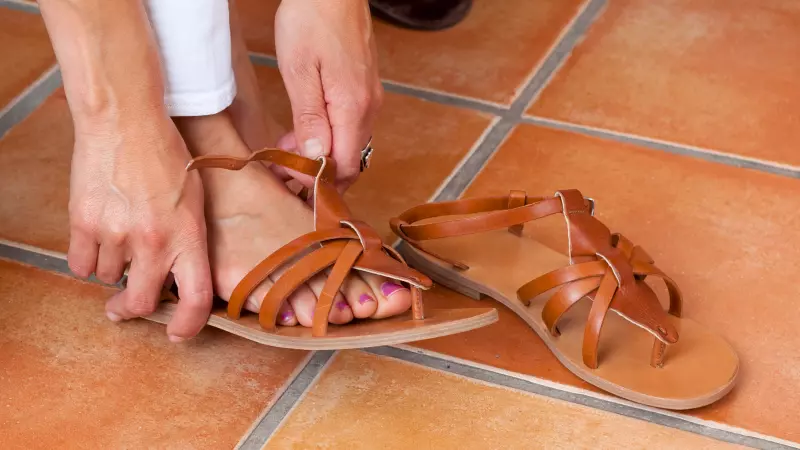How to Soften & Break In Leather Sandals
Leather sandals can be difficult to break in, especially if they are a snug fit for your feet. Nevertheless, leather is a natural material that can stretch and mold to your feet’s shape and size once you begin wearing your leather sandals regularly.
You can consider the following points to consider the best approach on how you can soften and break in your leather sandals.
- Natural Wear To Break In Sandals
- Applying Foot Lotion Before Wearing Sandals
- Loosening the Leather Strap
- Expanding the Leather Upper
- Flattening Arch of the Sandal Base
- Maintaining Your Leather Sandals
New leather sandals need a breaking-in period where the material relaxes with use and grows accustomed to your feet’s movement and contours. If your old leather sandals have hardened, poor care and maintenance may have been the cause for it.
Sweat on your leather sandals can stiffen the material as it dries, causing leather sandals to become uncomfortable or grimy. This is especially applicable if you live in tropical and warm climates.
Take note that sweat is especially damaging to leather as the natural pH level differs to leather, causing long term damage with prolonged and untreated exposure.
Don’t worry, we’ll help you out with that! This article will detail important tips on softening them so that you can keep your leather sandals comfortable and supple for a long time.
Natural Wear to Break in Leather Sandals
If your leather sandals are not too tight from the start, it is best to begin wearing them to break in the sandals. The more often you wear your leather sandals, the more likely you are to soften them with use.
Breaking in sandals made of hard leather can be uncomfortable, especially in the beginning. Nonetheless, you can wear those sandals for a short amount of time throughout the day to reduce the chance of blistering.
A perfect and controlled environment where you are able to do this is at home. Simply wear it around the house and if it ever gets too uncomfortable, you won’t be experiencing any inconvenience by swapping out or removing your footwear entirely.
If your leather sandals aren’t too tight, a pair of thin socks may do the trick if you’re breaking them in at home.
Applying Foot Lotion before Wearing Your Leather Sandals
Another way to break in a new pair of leather sandals is to apply foot lotion that’s made of all-natural ingredients before you wear them. Moisturizing your feet beforehand can help you protect your foot and soften the inside straps and soles of the sandal.
We advise applying an adequate amount of lotion to ensure your feet stay comfortable in the sandals and reduce the chances of abrasions or blisters. However, do not apply too much especially on the sole of your foot to the point where you are experiencing slipping against the sandal’s footbed as you walk.
Loosening The Sandal Strap
If you find breaking in your leather sandals by walking to be too uncomfortable of a process, you can use your hand to press and flex the leather straps of the sandal. This will relax the material and perform similarly to breaking in your sandals with your feet.
You can do this activity while watching TV or sitting on the patio with your pet. You can also insert a shoe tree or newspaper overnight inside your leather sandals to push the leather straps away and upwards from the sandal base.
This will help stretch out the material to your preferred size and make for comfortable usage. If you find it easier, you can use an instrument to assist you with this process to minimize any fatigue caused to your hands or fingers. Such instruments include comb handles, blunt utensils, and even water bottles.
Check out our complete guide on how to stretch your leather sandals. In this guide, we suggest several effective methods that you can follow to help stretch and loosen your leather sandals.
Expanding The Upper
If your leather sandals have an upper (typically designed like an arc that covers the top of your foot), then you can also loosen them in a similar way. Here, it’s best to also use a suitable shoe tree or some newspaper to slowly loosen the leather upper.
Take note not to apply too much pressure to the upper, as you won’t want it to come loose or get damaged in the process. It’s best to loosen the upper incrementally and test the results periodically.
Flattening Arch of The Sandal Base
Even if you purchase perfectly sized leather sandals, breaking in your new leather sandals can be challenging if you have flat feet. This is because sandals might come designed with an arch that might not be aligned with your flat feet.
Poorly fitting and pain inducing footwear can cause you to adopt an unusual and less than ideal gait, which can cause tired legs and a sore lower back. To mitigate and remedy this, we suggest using a spoon to mold the base of your sandals.
You can use a spoon to press down with pressure and mold the arch of your sandal’s base for a more comfortable wearing experience. You could also opt for suitable insoles for your leather sandals.
Reducing an arch of your sandal can be a transformative step to take if your sandals are causing you pain not due to it being oversized or undersized, but because of incompatibility with your flat feet.
Properly Maintain The Condition of Your Leather sandals
Poor maintenance and care is another cause of hardened leather sandals. Even though your leather sandals may be comfortable and soft right now, they can be exposed to damaging elements and stiffen over time if you don’t care for them and clean them properly.
Therefore, properly maintaining your leather sandals helps to soften them and also facilitates an easier breaking-in process. Below, you’ll find some of the best conditioning and maintenance tips for your leather sandals.
Wash and Condition Sandals
We recommend washing and conditioning your leather sandals twice a year for excellent upkeep and maintenance. You can use saddle soap, such as the Kiwi Saddle Soap, and water to rub away the dirt and grime from your leather sandals with a damp cloth or use a dedicated leather cleaner for the job.
After cleaning leather sandals, we highly recommend conditioning your leather sandals for more durable wear. You should particularly condition areas in regular and direct contact with your feet since they face the most wear and tear.
Let your sandals sit and dry off naturally on the back of conditioning them. Store your sandals in a naturally dry and airy environment overnight before using a clean cloth to wipe off any excess conditioner that might still exist before wearing them out.
Waterproof Leather Sandals
It is realistic to expect that your leather sandals will come into contact with water at some point when you wear them outside, whether due to rain or water from water sprinklers.
Water is highly detrimental to leather quality and can cause it to lose its natural oils and supple texture. If your leather sandals are exposed to water frequently or excessively, the material may dry out quickly, causing it to crack and become brittle.
Every time you clean your leather sandals, we suggest using a waterproofing spray or wax to protect them from future water damage owing to accidental spills or splashes. Check out our review of the Nikwax Waterproofing Wax for Leather to understand how these products work.
Before applying your waterproof spray or wax, we recommend testing it on an inconspicuous area of your leather sandals. We want to ensure that no discoloration occurs.
Once that is ascertained and you are confident of proceeding, coat the entire surface area of your leather sandals with your waterproof product. Damage from future exposure to moisture or liquids can be heavily mitigated as a result.
How to Choose the Right Leather Sandal Size
When you buy a new pair of leather sandals, it is best to select a pair that fits your feet just right. The leather material becomes softer and more stretchable with time and will allow you a wider and more comfortable range of movement as you wear them.
Although the leather material of your sandals will expand with use and time, you should not buy leather sandals that are too tight and cut into your feet from the beginning.

About Matthew
Co-Founder, Editor-in-Chief & Writer At Leatherskill
I’m a leather enthusiast turned artisan. Apart from crafting leather products, I’m passionate about writing in-depth guides and reviews on all things leather!

